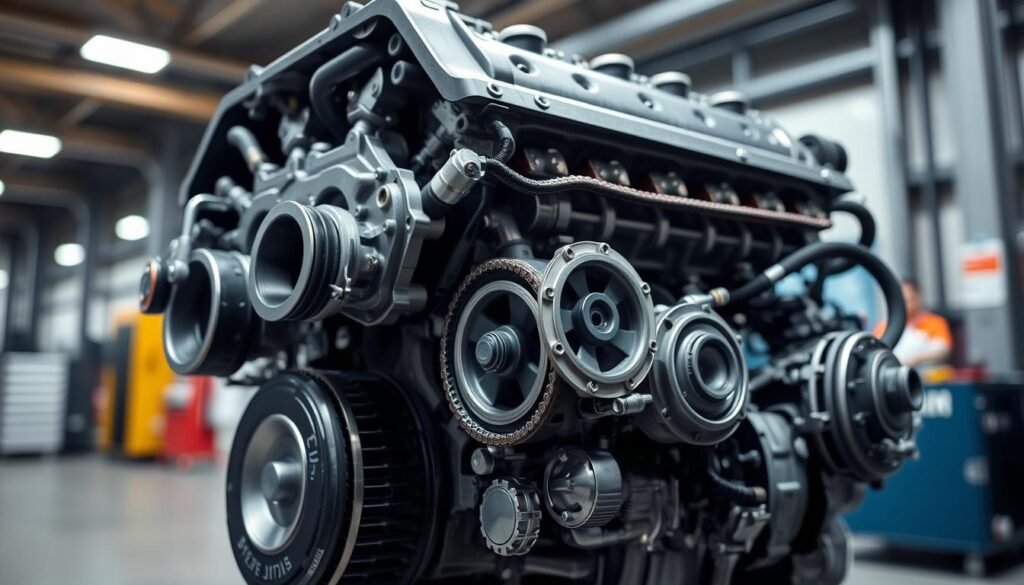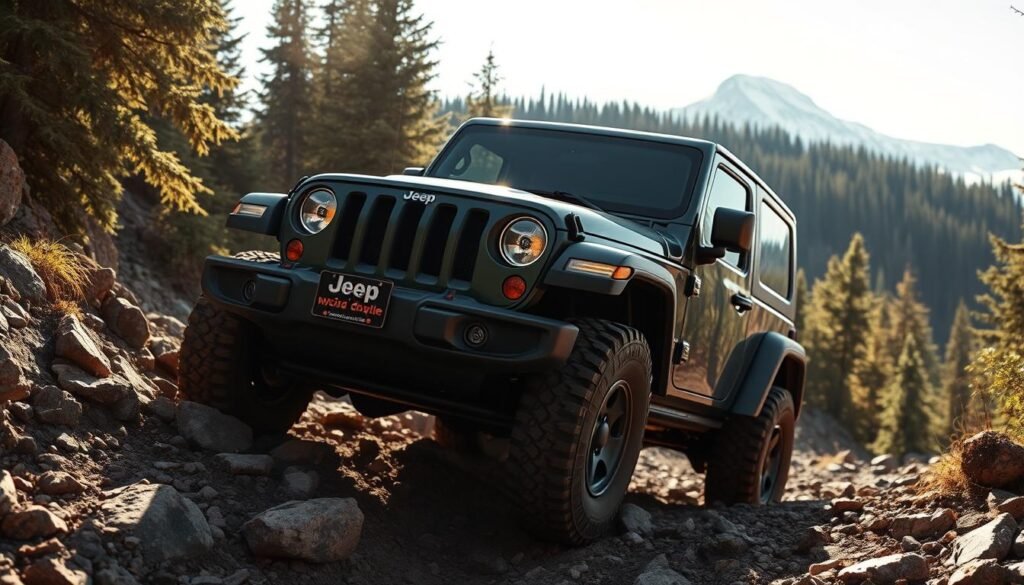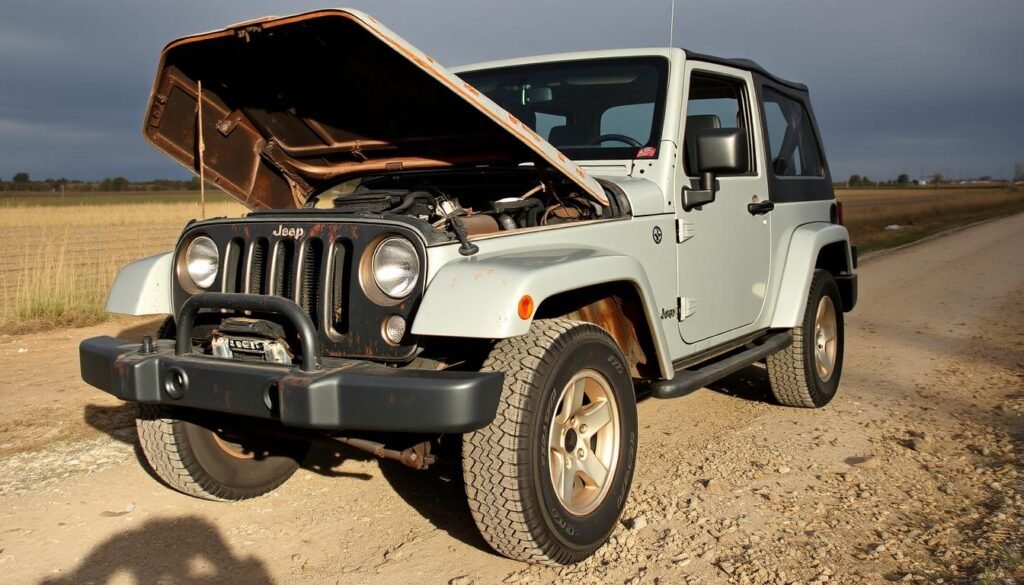Did you know over 10 million vehicles have the 3.6L FCA Pentastar V6 engine? It’s used in Chrysler, Dodge, and Jeep models. But, some owners face problems with it.
The engine is in many models like the Challenger and Jeep Grand Cherokee. While it’s praised for its performance, some have complaints. A Mopar technician said there are recurring issues.
Common problems include misfires and ticking sounds. These are often due to failing roller rocker arms. If not fixed, it can cause more damage, like camshaft wear. The Time Sert 8313 head bolt thread repair kit is very popular.
Despite these issues, the engine is powerful and fuel-efficient. With good care, it can last a long time. Some engines even reach 500,000 miles.
3.6L Pentastar V6 Engine
The 3.6L Pentastar V6 engine has been a key part of Chrysler, Dodge, and Jeep cars and trucks for over a decade. It has powered more than ten million vehicles. These range from family minivans to tough SUVs.
Engine Production History
The 3.6L Pentastar V6 engine was introduced in 2010. It quickly became a mainstay in the Chrysler family. For over a decade, it has been made with improvements to fix any issues.
Vehicle Applications
The Pentastar engine is used in many vehicles. It’s found in:
- Chrysler 300 and Pacifica
- Dodge Challenger, Charger, and Durango
- Jeep Grand Cherokee and Wrangler
- Ram 1500 and ProMaster
Design Features and Specifications
The 3.6L Pentastar V6 engine has many innovative features. These help it perform well and efficiently. Some of these include:
| Feature | Specification |
|---|---|
| Displacement | 3.6 liters |
| Horsepower | 283-305 hp (depending on application) |
| Torque | 260-269 lb-ft (depending on application) |
| Valvetrain | Dual overhead camshaft (DOHC) |
| Fuel System | Sequential multi-port fuel injection |
While the 3.6L Pentastar V6 engine is generally reliable, some problems have been reported. These issues can be minor or serious, needing professional help.
Engine Misfire and Check Engine Light Issues
The 3.6 Pentastar engine often has problems like misfires and check engine lights. These issues are common in Jeep Wranglers. They usually come from cylinder head failures.
Cylinder Head Failure Symptoms
Cylinder head failures in the 3.6 Pentastar engine show up as misfires, often in cylinder #2. Drivers might feel a shudder or see a drop in engine power. The check engine light will turn on, showing codes like P0302 for a misfire in cylinder 2.
Valve Seat Overheating
Valve seat overheating is a main cause of these problems. It’s due to a design flaw in the exhaust valves. These valves can warp at high temperatures. This issue is common in “A” batch heads made before mid-2011. “B” batch heads have also shown similar problems.
Warranty Coverage Options
Dodge knows about these engine problems but only fixes them after misfires and trouble codes show up. Owners should check their engine’s casting date to see if it’s in a known bad batch. Even if the head looks okay, it’s smart to be ready for issues.
| Engine Batch | Issue Status | Action Taken |
|---|---|---|
| “A” Batch (pre mid-2011) | Confirmed design flaw | Potential for problems |
| “B” Batch | Ongoing issues reported | Intended to resolve “A” batch problems |
| “C” Batch | Introduced as solution | Response to “B” batch issues |
Ticking Sound in the Engine
The 3.6 Pentastar Engine Problems often include a distinctive ticking noise, known as the “Pentastar tick.” This issue has plagued many owners. The ticking sound usually comes from rocker arm failure, a common problem in these engines.
Rocker Arm Failure Diagnosis
Diagnosing rocker arm failure in 3.6 Pentastar engines involves listening for a persistent ticking noise, mostly during startup. This sound comes from failed valve lifters, tappets, or worn camshaft. The engine’s design can lead to oil starvation on startup, causing metal-on-metal contact and wear.
Repair Costs and Labor Requirements
Fixing 3.6 Pentastar Engine Problems related to rocker arm failure can be expensive. Here’s a breakdown of the costs:
| Repair Item | Cost Range |
|---|---|
| Replacing 12 rockers in cylinder head | $1,500 – $2,000 |
| Individual rocker replacement | ~$10 each |
| Camshaft replacement | $350+ |
| Engine swap labor | $1,000+ |
Early detection of the ticking noise may require replacing one or no camshafts. But, it’s common for two or more camshafts to need replacement. To reduce wear, some owners use engine oil additives or install a Baxter Performance adapter for better oil retention.
Engine Overheating Concerns
Engine overheating is a big problem for 3.6 Pentastar engines. It affects many Chrysler, Dodge, and Jeep cars with this engine. Over ten million vehicles have this engine, so fixing overheating is key.
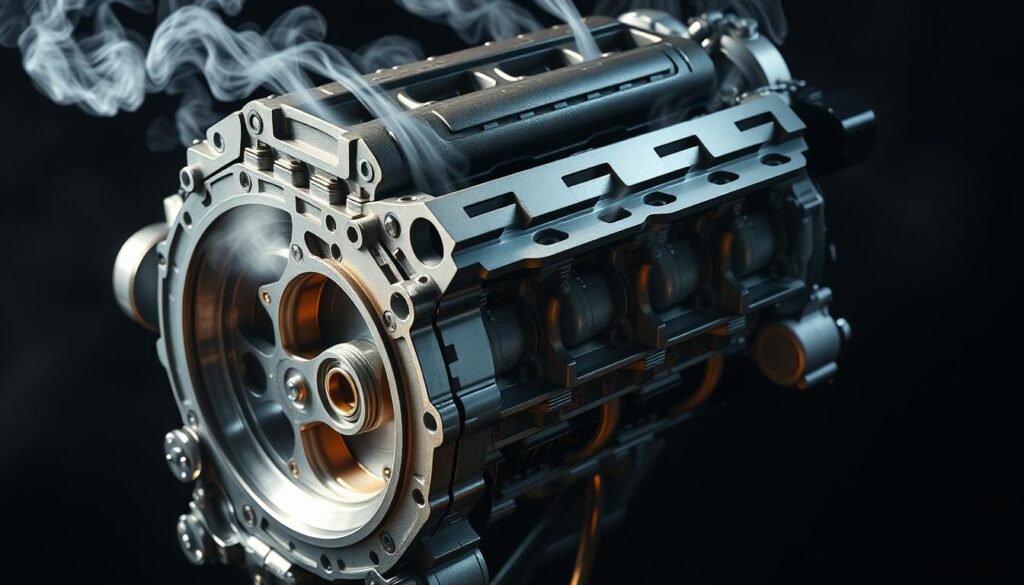
Overheating often comes from cooling system failures. Coolant leaks, bad thermostats, and faulty water pumps are common causes. The engine’s design can also lead to sand in coolant passages, causing sludge.
Signs of overheating include a high temperature gauge, coolant smells, and leaks. You might see steam or notice the engine acts strangely. It’s important to check coolant levels, hoses, belts, and the water pump regularly.
“Regular coolant flushes are essential for maintaining the 3.6 Pentastar engine, especialy in Dodge, Jeep, or Chrysler vehicles.”
Keep an eye on your temperature gauges and warning lights. Follow the manufacturer’s maintenance schedule and fix cooling system problems fast. If you think your engine is overheating, get help from skilled mechanics who know about 3.6 Pentastar engine issues.
Tapping, Knocking, and Rattling Symptoms
The 3.6 Pentastar engine often makes strange noises. If you drive a 2014 Jeep Wrangler, you might hear tapping, knocking, or rattling sounds. These sounds can be scary and might mean serious problems.
Oil Pump Failure Signs
A loud tapping noise that gets softer as the engine warms up might mean oil pump failure. This is called the “Pentastar Tick.” It starts softly and gets louder over time. It’s important to fix this quickly to avoid more damage and expensive repairs.
Oil Pressure Problems
Low oil pressure often goes with oil pump failure. You might hear the tapping noise from far away. If you notice this, it’s a good idea to get your car checked, even if there are no trouble codes.
Sand Deposits in Cylinder Head
Knocking or rattling sounds can come from sand in the cylinder head. These sounds might not match the engine’s rhythm and happen when starting. Some people have tried adding Sea Foam to the oil to clean it. But, getting a professional diagnosis is best.
| Symptom | Possible Cause | Action |
|---|---|---|
| Loud tapping noise | Oil pump failure | Immediate inspection |
| Knocking sound | Cylinder head deposits | Professional cleaning |
| Rattling at startup | Low oil pressure | Oil system check |
The 3.6 Pentastar engine problems, like these noises, are part of a class action lawsuit. If you own a Chrysler, Dodge, Jeep, or RAM with this engine, watch out for these symptoms. This can help prevent big damage.
Cooling System Failures
The 3.6 Pentastar engine often faces cooling system failures. These problems can cause serious engine damage if not fixed quickly. Let’s look at the main reasons for cooling system breakdowns in this engine.
Water Pump Issues
Water pumps are key in moving coolant through the engine. If they fail, coolant flow stops, causing overheating. Look out for coolant leaks, strange noises, and temperature gauge changes.
Radiator Problems
Radiators are essential for cooling the engine. Damage or clogs can make them less effective, leading to overheating. Regular checks can spot leaks or blockages early.
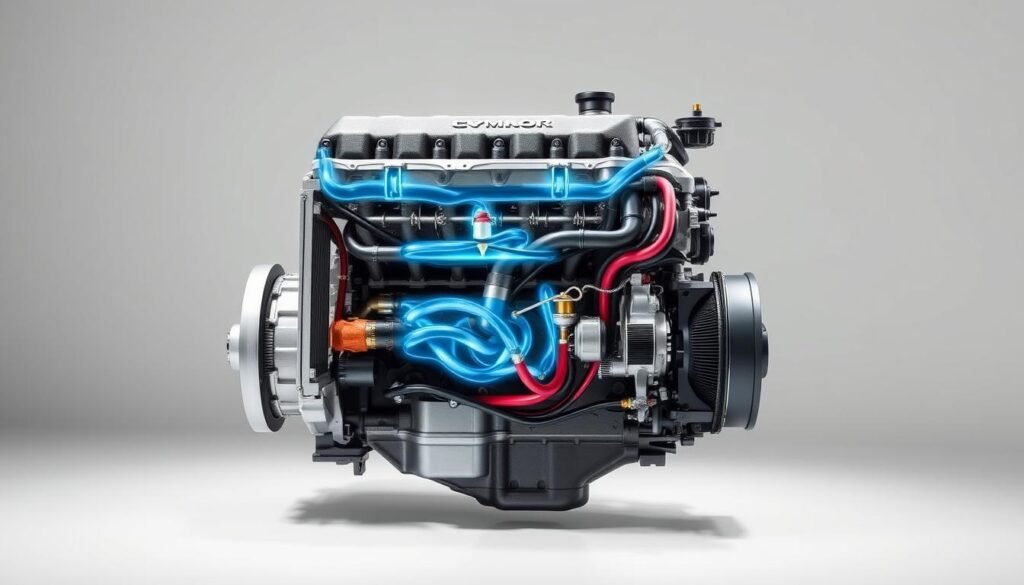
Coolant Flow Complications
Coolant flow can be affected by several factors in the 3.6 Pentastar engine. Sand from the casting process can block coolant passages, causing sludge buildup. Regular coolant flushes are key to avoid blockages.
Hoses and belts that carry coolant can wear out, leading to leaks or restricted flow. It’s important to check these regularly and replace them when needed.
| Component | Common Issues | Prevention |
|---|---|---|
| Water Pump | Leaks, bearing failure | Regular inspections |
| Radiator | Clogging, damage | Coolant flushes, visual checks |
| Hoses/Belts | Deterioration, cracks | Routine replacement |
To avoid these 3.6 Pentastar engine issues, follow the manufacturer’s maintenance schedule. Use top-quality coolant and keep an eye on temperature gauges. Quick action on cooling system problems can prevent expensive repairs later.
Maintenance Requirements and Prevention
Keeping your 3.6 Pentastar engine in top shape is key to avoiding common problems. Regular maintenance can save you from costly repairs down the road. Let’s look at some essential upkeep tasks to keep your engine running smoothly.
Oil changes are critical for your Pentastar engine. Use the right type of oil and change it every 5,000 to 7,500 miles. This helps prevent low oil pressure and keeps harmful deposits from building up in your engine. Don’t forget to replace the oil filter too – using the wrong one can lead to leaks.
Your cooling system needs love too. Flush it every 30,000 to 50,000 miles to ward off overheating issues. Check your water pump and radiator regularly for signs of wear or damage. These parts are often behind 3.6 Pentastar engine problems related to overheating.
- Replace air filters as scheduled
- Check and replace spark plugs when needed
- Inspect the serpentine belt for proper routing
- Listen for unusual noises like ticking or rattling
By sticking to these maintenance tips, you can catch problems early. This proactive approach helps prevent many common 3.6 Pentastar engine problems. It keeps your vehicle running strong for years to come.
Professional Repair Solutions
When you face problems with a 3.6 Pentastar engine, you often need professional help. These engines are complex, needing special knowledge and tools. For example, overheating can start around 77,000 miles, with temperatures hitting up to 250°F.
It’s important to choose a skilled mechanic or dealership. They can do detailed tests, like a 12-hour pressure test, to find engine issues. With over 1,000 Pentastar engines waiting, professional repairs are in high demand. Experts can fix problems like warped oil filter housings and cracked cooler assemblies, common in these engines.
Professional repairs can cost a lot, from $125 to $800 for oil filter housing replacements. But, they’re usually the best choice for fixing 3.6 Pentastar engine problems. Mechanics can use OEM parts or high-quality alternatives like Dorman’s aluminum oil filter housing. While DIY fixes might seem appealing, complex issues like valve train defects need expert care for your vehicle’s safety and long life.
FAQ
What are the most common problems with the 3.6 Pentastar engine?
Common issues include engine misfires and cylinder head failure. You might also hear ticking sounds from rocker arm problems. Overheating and unusual noises like tapping or knocking are also common. But, many 3.6 Pentastar engines work well with regular maintenance.
Which vehicles use the 3.6L Pentastar V6 engine?
The 3.6L Pentastar V6 engine is in many Chrysler, Dodge, and Jeep models. You can find it in the Jeep Wrangler, Jeep Grand Cherokee, Chrysler 300, Dodge Charger, and Ram 1500.
What are the symptoms of cylinder head failure in a 3.6 Pentastar engine?
Signs of cylinder head failure include engine misfires and a check engine light. You might also notice reduced performance and coolant leaks. Valve seat overheating is a big problem in some Jeep Wranglers.
How can I diagnose rocker arm failure in my 3.6 Pentastar engine?
Rocker arm failure makes a ticking sound. If you hear this, get your car checked by a mechanic. They can figure out if you need new rocker arms.
What causes overheating in the 3.6 Pentastar engine?
Overheating can happen due to coolant leaks, bad thermostats, or water pump failures. It’s important to fix overheating quickly to avoid engine damage.
What do tapping, knocking, and rattling sounds indicate in a 3.6 Pentastar engine?
These sounds might mean oil pump failure, oil pressure issues, or sand in the cylinder head. If you hear odd noises, get your engine checked by a pro to find and fix the problem.
How often should I perform maintenance on my 3.6 Pentastar engine?
Stick to your car’s maintenance schedule. This includes oil changes, air filter swaps, and cooling system checks. Regular care helps avoid many problems and keeps your engine running longer.
Are there any known warranty extensions for 3.6 Pentastar engine issues?
Yes, some problems like cylinder head failures in certain years have extended warranties. Check with your local dealership or Chrysler customer service to see if you qualify.
When should I seek professional repair for my 3.6 Pentastar engine?
Get professional help if you see persistent check engine lights, odd noises, performance drops, or overheating. Some issues need special tools and knowledge, so a pro is best for fixing them right.
Are aftermarket parts suitable for repairing 3.6 Pentastar engines?
Aftermarket parts might be cheaper, but OEM parts are usually better for performance and reliability. Talk to your mechanic about the benefits and drawbacks of each when deciding on repairs.
